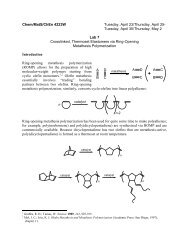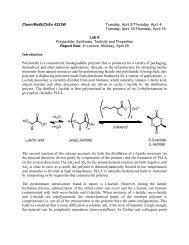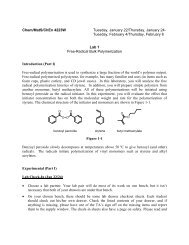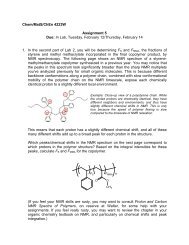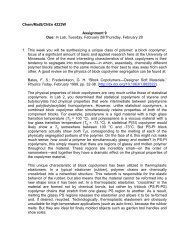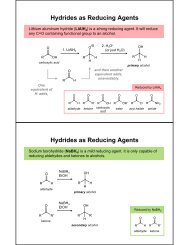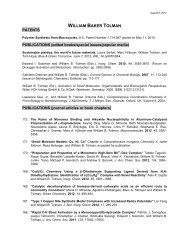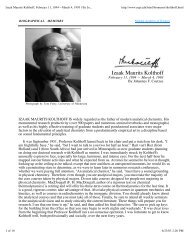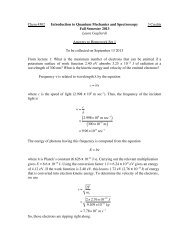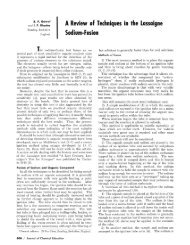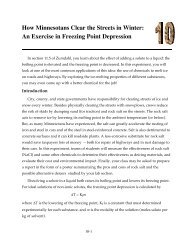Ion-Selective Electrodes With Ionophore-Doped Sensing Membranes
Ion-Selective Electrodes With Ionophore-Doped Sensing Membranes
Ion-Selective Electrodes With Ionophore-Doped Sensing Membranes
You also want an ePaper? Increase the reach of your titles
YUMPU automatically turns print PDFs into web optimized ePapers that Google loves.
<strong>Ion</strong>ophore-doped sensing membranes 2561<br />
of 1 : 2 complexes and inhibiting the binding of larger<br />
ions. The highest potentiometric selectivity was reported<br />
for Li + -II (10 3.3 -fold over Na + ), 102 but similar selectivities<br />
were also found for several other compounds. 103<br />
Interestingly, a more than 10 4 -fold selectivity but a slow<br />
response was reported for the sterically even more hindered<br />
Li + -III. 103<br />
A fair number of ionophore-based ISEs with selectivities<br />
for Rb + and Cs + , the two largest alkali metal cations,<br />
have also been described. In some of these cases, the<br />
potentiometric selectivities suggest that the ionophore binds<br />
the target ion selectively. However, in a number of cases<br />
such evidence is missing. Since Cs + has the lowest free<br />
energy of hydration of all alkali metal cations, even<br />
an ionophore-free ion-exchanger membrane will exhibit<br />
selectivity for Cs + over the other alkali metal cations. To<br />
show evidence for selective recognition of Cs + by the<br />
ionophore, the selectivity of an ionophore-based ISE for<br />
Cs + has be higher than for an ionophore-free ion-exchanger<br />
ISE based on a membrane containing the same membrane<br />
components but no ionophore (but including ionic sites),<br />
a control experiment that is unfortunately too often not<br />
reported.<br />
4.3.2 <strong>Ion</strong>-selective electrodes for NH 4<br />
+<br />
Because of the key role of NH + 4 in various biological<br />
processes, the direct measurement of this ion is important<br />
for clinical and environmental analyses. Ammonium concentrations<br />
in food also provide a measure of freshness.<br />
Moreover, various enzymes catalyze the deamination of<br />
numerous organic compounds, which makes NH + 4 selective<br />
ionophores also of interest for enzyme-based ISEs<br />
(Section 3.1.7). For all these reasons, there has been a continued<br />
interest in the development of ionophore-based ISEs<br />
for NH + 4 .<br />
For many years, almost all the work on NH + 4 ISEs<br />
focused on the macrocyclic antibiotics nonactin (NH + 4 -I)<br />
and monactin (NH + 4 -II), see Figure 3. 4, 104 While the type<br />
of sensing matrix has some effect on the selectivities of<br />
ISEs based on these ionophores, an approximately 10-<br />
fold selectivity over K + and an approximately 100-fold<br />
selectivity over Na + is characteristic for these sensors.<br />
Only in recent years several interesting alternatives have<br />
been proposed. Significant improvements of the selectivity<br />
of either Na + or K + have been obtained by use of<br />
rigid crown ethers with bulky substituents that block<br />
complexation with larger ions (e.g.,NH + 105, 106<br />
4 -III), a<br />
O<br />
O<br />
O<br />
O<br />
N<br />
H<br />
NHO<br />
HN<br />
O<br />
O<br />
O<br />
O<br />
O<br />
O<br />
O O<br />
NH 4 + -IV<br />
O<br />
O<br />
O<br />
O<br />
NH<br />
N<br />
H<br />
HN<br />
O<br />
HN<br />
O<br />
NH 4 + -III<br />
NH 4 + -VI<br />
O<br />
O<br />
O<br />
O<br />
O<br />
O<br />
(CH 3 ) 2 Si<br />
O<br />
O<br />
O<br />
O<br />
O<br />
(CH 3 ) 2 Si<br />
Si<br />
O<br />
Si(CH 3 ) 2<br />
O<br />
Si(CH 3 ) 2<br />
O<br />
O<br />
O<br />
O<br />
O<br />
NH 4 + -V<br />
O<br />
O<br />
O<br />
O<br />
O<br />
O



